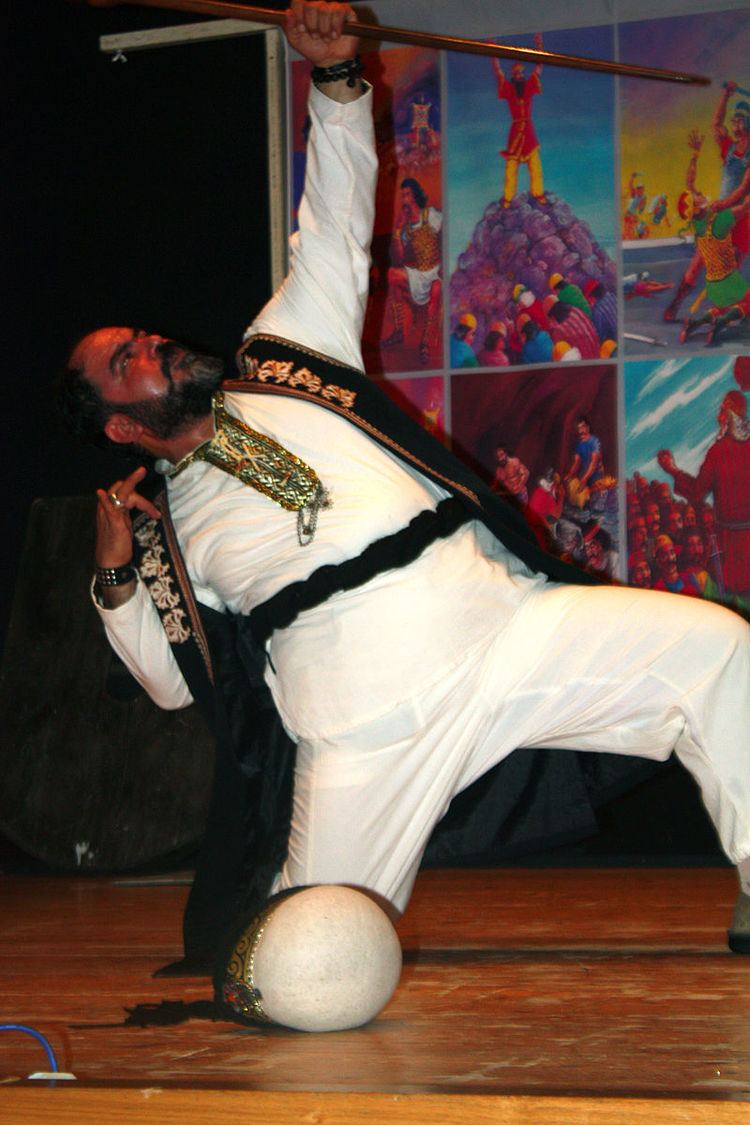 | ||
Persian theater or Iranian theater (Persian:تئاتر در ایران) goes back to antiquity. The first initiation of theater and phenomena of acting can be traced in ceremonial theaters to glorify national heroes and legends and to humiliate the enemy, as in the classics "Soug Sivash" and "Mogh Koshi" (Megakhouni). Ancient Persian theatre and dance was significantly researched by the Greek historian Herodotus of Halikarnassos, who lived during the Persian rule in Greece. In his work Book IX (Calliope), he describes the history of Asian empires and also the Persian wars until 478 BC.
Contents
Historical Persian theatre
These are a few of the dramatic performing arts that became popularized in Iran in 7th century AD, long before the advent of cinema. A few examples include:
Naqqāli
Naqqāli is one of the oldest forms of the traditional Persian theatre. The Naqqāli is the performer and recounts stories in prose often accompanied by music, dance and decorative, painted scrolls. Both men and women can be Naqqāli performers and can perform with mixed-sex audiences, which is unusual in Iran. The performer often wears simple costumes and a single piece of a historical but related costume, like one old piece of armour. This art was formerly performed in coffeehouses, private houses and historical venues such as ancient caravanserais. A decline in the popularity of coffeehouses in Iran, and with new forms of entertainment, has resulted in diminishing interest in Naqqāli performance. The aging of master performers, (who are called morsheds) and the decreasing popularity among younger generations have caused a steep drop in the number of skilled Naqqāls, threatening the survival of this dramatic art. Naqqāli was included in 2011 to the UNESCO's Representative List of the Intangible Cultural Heritage of Humanity in need of urgent safeguarding. Other similar Iranian story-telling and performance traditions include Naghali, Pardeh-dari, Pardeh-khaani, Ghavali (minstrelsy), Shahnameh-khaani, Ta'zieh.
Ta'zieh
Ta'zieh, also known as Tazieh, is a form of traditional, religious Persian theatre in which the drama is conveyed through music, narration, prose and singing. Ta'zieh dates from before the Islamic era. A common theme is the epic tragedy of Siavash in Shahnameh of Ferdowsi. In Persian tradition, Ta'zieh and Parde-Khani are inspired by historical and religious events, and symbolize epic spirit and resistance. The common theme is hero tales of love, sacrifice, and resistance against evil. Ta'zieh resembles the European opera in many respects.
Kheimeh Shab Bazi
Kheimeh-shab-bazi is the Persian traditional puppetry which is performed in a small chamber. There are two people involved in the performance: a musical performer and a person telling the story (called a morshed). The dialogue is between morshed and the puppets. The method of performance, its characters and the techniques used in writing the puppet show make it unique and distinguish it from other types of puppetry. A newer genre of Iranian puppetry emerged during Qajar era. Puppetry is still very common in contemporary Iran.
Siah-Bazi
Siah-Bazi, also known as Siyah-Bazi is a type of Iranian folk performing art that features a blackface, mischievous and forthright harlequin that does improvisations to stir laughter. The term Siah-Bazi literally translates to "playing black" and is a sketch in which two men dressed in red turbans, one has black face paint and they engage in a verbal duel which is often witty, political in nature and humorous. The character with the black face takes on a clown-like role and tries to disgrace the master. Outwardly the master appears to be a respectable person but underneath he is immoral and not to be respected. The blackface character is portrayed as a carnivalesque underdog of the working class and the audience can empathize with their struggle through humor. Siah-Bazi has been compared to American minstrel theater and have similar controversy.
Siah-Bazi and Ru Howzi both have a blackface clown character and involve lewd jokes, but Ru Howzi is a social theatre that satirizes domestic life and is often performed at private Iranian residences on a stage over a pool of water that is often found in home courtyards. Siah-Bazi is performed in more public places like theatres or coffee houses because of the political subject matter.
The Iranian Revolution affected the tone and performance of Siah-Bazi, and they edited away the sexual references, dancing and music. The performances continue only because of the acceptance of the standards of the Islamic Iranian Revolution.
Contemporary Persian theatre
The Iranian professional theatre movement is especially active in Iran's main city, Tehran. Rostam and Sohrab puppet opera is an example of the most common type of Kheimeh-Shab-Bazi performance you would see in modern-day Iran.
In modern times, Bahram Beyzai has made the most significant contribution in the historiography of Persian theatre with his seminal book A Study on Iranian Theatre.
